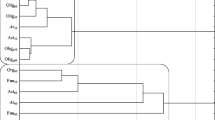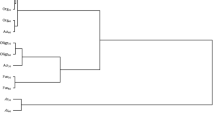Summary
Field disinfestation in autumn with normal or increased dosages of 1,3-dichloropropene, metham-sodium or chloroform, and in spring with ethoprophos, did not, or hardly, affect the degradationin situ of some herbicides applied in spring. However, during laboratory incubation of samples from the disinfested plots, sometimes decreased herbicide degradation rates or increased lag phases were found.
The top few centimetres of the field soil, on which the herbicides were sprayed, apparently largely escaped fumigation. Accordingly, effects of fumigation on herbicide degradation, organic matter and N metabolism were stronger in samples from the 10–20 cm layer than in samples from 0–10 cm.
In the laboratory fumigation of soil samples with CHCl3 was much more drastic in inhibiting herbicide degradation, N mineralisation and nitrification; inoculation with 10% fresh soil, however, greatly accelerated the recovery of these processes. Therefore, in practice prolonged or drastic effects of chemical soil disinfestation on metabolic integrity of the soil are not to be expected.
Similar content being viewed by others
References
Anderson J R 1978 Pesticide effects on non-target soil microorganisms.In Pesticide Microbiology. pp. 313–533. Eds. I R Hill and S J L Wright. Academic Press, London.
Jenkinson D S and Powlson D S 1976 The effects of biocidal treatments on metabolism in soil. Soil Biol. Biochem. 8, 209–213.
Lawrence J F and Turton D 1978 HPLC data for 166 pesticides. J. Chromatography 159, 207–226.
Leistra M 1972 Diffusion and adsorption of the nematicide 1,3-dichloropropene in soil. Agric. Research Reports 769. 105 p. Pudoc, Wageningen.
Oostenbrink M 1960 Estimating nematode populations by some selected methods.In Nematology. pp. 85–102. Eds. J N Sasser and W R Jenkins. Univ. N. Carolina Press, Chapel Hill.
Smelt J H and Leistra M 1974 Conversion of metham sodium to methyl isothiocyanate and basic data on the behaviour of MIT in soil. Pestic. Sci. 5, 401–407.
Smelt J H, Leistra M and Voerman S 1977 Movement and rate of decomposition of ethoprophos in soil columns under field conditions. Pestic. Sci. 8, 147–151.
Simon-Silvestre G and Fournier J C 1979 Effects of pesticides on the soil microflora. Adv. Agron. 31, 1–92.
Zantua M I and Bremner J M 1975 Comparison of methods of assaying urease activity in soils. Soil Biol. Biochem. 7, 291–295.
Author information
Authors and Affiliations
Rights and permissions
About this article
Cite this article
Van Faassen, H.G., Lebbink, G. Chemical disinfestation and metabolic integrity of soil. Plant Soil 76, 389–400 (1984). https://doi.org/10.1007/BF02205596
Issue Date:
DOI: https://doi.org/10.1007/BF02205596




